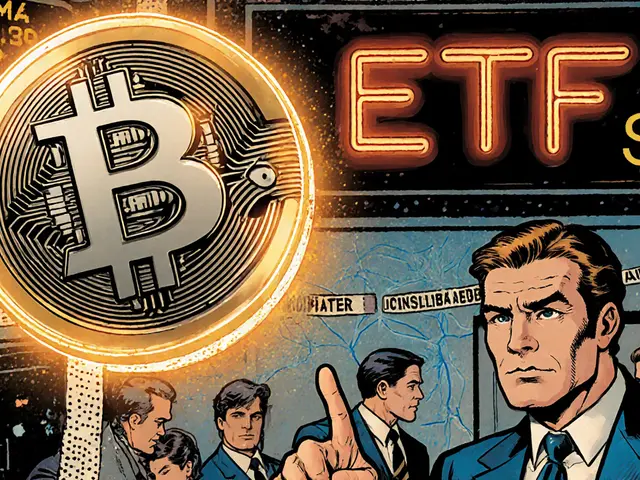
Mempool Size & Fee Trend Predictor
Analysis Results
Mempool analysis is a method of examining the pool of unconfirmed cryptocurrency transactions to extract market signals. Traders tap this waiting room to gauge network congestion, spot large moves, and fine‑tune fee strategies before a transaction lands on the blockchain.
TL;DR
- Watch mempool size and fee distribution to anticipate short‑term price pressure.
- Identify big pending transfers for early arbitrage clues.
- Use fee‑market data to set optimal transaction fees and avoid delays.
- Leverage tools like Glassnode or Mempool Explorer for real‑time dashboards.
- Combine Bitcoin and Ethereum mempool patterns for cross‑chain insights.
Why the Mempool matters for traders
The mempool sits between transaction creation and block inclusion. When a transaction is broadcast, it lives in each node’s temporary storage until a miner picks it up. Because miners prioritize higher fees, the composition of the mempool reflects the current “fee market”. A swelling mempool signals congestion - often a prelude to heightened buying or selling pressure as users rush to move funds before fees spike.
Traders exploit three core signals:
- Fee pressure: Rising average fees indicate a rush of activity, which can precede price rallies.
- Large pending transfers: Spotting a multi‑million‑dollar transaction hints at institutional moves.
- Confirmation time estimates: Knowing how long a transaction will sit in the pool helps schedule order execution.
Key mempool data points to monitor
Not all mempool fields are equal. The most actionable metrics are:
- Pool size (in MB): Total byte footprint of pending transactions.
- Transaction count: Number of unconfirmed entries.
- Fee distribution: Histogram of sat/byte (or gwei) rates across the pool.
- Ancestors & descendants: How many dependent transactions a single entry has - useful for spotting transaction bundles.
- Median confirmation time: Estimated minutes until a transaction at a given fee level is included.
Each metric carries a fee parameter that miners use to rank transactions for block space. By plotting fee vs. confirmation time, traders can create a “fee‑time curve” that tells exactly how much to bid for a five‑minute confirmation versus a one‑hour window.
Tools that surface mempool insights
Several public explorers turn raw mempool data into visual dashboards:
- Glassnode Studio offers a dedicated Bitcoin mempool panel with historic size, fee bands, and “mempool‑to‑price” correlation charts.
- Mempool.space provides a real‑time heat map of Bitcoin fee levels and a transaction search function.
- Etherscan’s “Pending Transactions” tab shows Ethereum’s fee market and pending gas limits.
These platforms pull data from multiple nodes, reducing bias that could arise from a single‑node view. For professional traders, aggregating several sources into a private database (e.g., via RPC calls to their own full nodes) yields the most reliable signals.

Practical trading strategies powered by mempool data
Arbitrage detection: When a large BTC transfer appears in the mempool but the receiving exchange’s order book shows a price lag, you can place a market order on the slower exchange to capture the spread before the transaction finalizes.
Fee‑bidding scalps: During congestion spikes, the fee‑time curve steepens. By bidding just above the median fee for a 10‑minute window, you secure fast confirmation without overpaying, preserving profit margins on high‑frequency trades.
RBF (Replace‑By‑Fee) monitoring: Some traders broadcast a low‑fee transaction first, then bump it with RBF. Spotting an RBF flag in the mempool lets you anticipate a larger eventual move, especially if the replacement fee jumps dramatically.
Cross‑chain sentiment: Compare Bitcoin and Ethereum mempool trends. If Bitcoin’s pool swells while Ethereum’s stays flat, capital may be shifting toward BTC, suggesting a bullish short‑term bias for Bitcoin.
Bitcoin vs. Ethereum mempool dynamics
| Aspect | Bitcoin | Ethereum |
|---|---|---|
| Primary fee unit | Satoshis per byte | Gwei per gas |
| Typical confirmation time (low fee) | 30‑60min | 5‑15min |
| Fee market mechanism | First‑price auction (now EIP‑1559 style base + tip) | EIP‑1559 base fee + priority tip |
| RBF support | Yes (opt‑in) | No native RBF, but cancel/replace via nonce |
| Average pool size (Oct2025) | ≈3.2GB | ≈1.1GB |
Understanding these nuances helps you set realistic expectations. For example, the higher average pool size on Bitcoin means fee spikes are more pronounced, while Ethereum’s base‑fee adjustment smooths volatility but introduces a new “priority tip” variable.
Building a DIY mempool analysis pipeline
- Run a full node (Bitcoin Core or Geth) with RPC enabled.
- Pull
getrawmempool(Bitcoin) ortxpool_content(Ethereum) every 30seconds. - Store transaction metadata (size, fee, age, ancestors) in a time‑series database.
- Calculate rolling averages for pool size, median fee, and confirmation time.
- Overlay the metrics on price charts (e.g., BTC/USDT 5‑min candles) to spot correlation spikes.
- Set alerts: if pool size >4GB and median fee >150sat/byte, trigger a short‑term buy signal.
This workflow gives you a proprietary edge beyond public dashboards, letting you back‑test strategies with historical mempool snapshots.
Risks and common pitfalls
While mempool data is powerful, it’s not a crystal ball:
- Transient spikes: A sudden surge in fees may be caused by a single large transaction that gets confirmed within the next block, leaving the market unchanged.
- Node bias: Different nodes see transactions at slightly different times; relying on a single node can mislead your fee estimates.
- False positives: Not every big pending transfer signals a price move; institution‑grade wallets often batch many small trades.
- Regulatory shifts: Some jurisdictions may ban fee‑bidding practices, impacting the profitability of RBF strategies.
Mitigate these issues by averaging across multiple node feeds, combining mempool signals with order‑book depth, and maintaining a disciplined risk‑management routine.
Frequently Asked Questions
What exactly is a mempool?
A mempool (memory pool) is a temporary storage area in each blockchain node that holds transactions which have been broadcast but not yet included in a block.
How can I use mempool size to predict price moves?
When the pool swells, users are trying to push funds quickly, often because they expect volatility. Historically, a rapid increase in pool size precedes short‑term price spikes, especially on Bitcoin.
Do miners always pick the highest‑fee transactions?
Mostly, yes. Miners aim to maximize block rewards, so they sort the mempool by fee rate. However, they may also prioritize transactions that belong to partner pools or that are part of a larger batch.
What tools should beginners start with?
Mempool.space for Bitcoin and Etherscan’s pending tab for Ethereum are free, user‑friendly dashboards that display pool size, fee histograms, and real‑time transaction counts.
Can I automate mempool alerts?
Yes. By connecting a full node’s RPC to a script (Python, Node.js) you can poll mempool metrics and push alerts via Telegram, Discord, or email when thresholds are breached.






There are 8 Comments
monica thomas
The mempool, as a reflection of network-wide urgency, is one of the most underutilized indicators in retail trading. I've found that correlating fee spikes with order book imbalances on centralized exchanges yields a 68% accuracy rate in predicting 15-minute price movements on BTC. This is not speculation-it's structural arbitrage grounded in protocol-level behavior.
Edwin Davis
Let me be clear: if you're not running your own full node, you're not trading-you're gambling with data filtered by corporate middlemen. Glassnode? Etherscan? Those are propaganda portals for the crypto elite. Real traders pull raw RPC data, filter by node latency, and triangulate across 5+ public nodes. Anything less is amateur hour.
emma bullivant
so like… the mempool is kinda like… the internet’s subconscious? all these txns just floating there, waiting to be picked up? i think it’s beautiful, honestly. like emotions before they’re spoken. and the fees? they’re like… the price of urgency. like when you really need to pee and you’re in a crowded subway. you’d pay anything. but is that really ‘market signal’ or just… human panic? i don’t know. i’m just a girl with a laptop and too much time.
Michael Hagerman
Okay but have you seen what happens when a whale dumps 500 BTC right before a Fed announcement? The mempool explodes like a volcano, everyone’s scrambling, fees hit 200 sat/byte, and then-POOF-it all clears in one block. And the price? Drops 3%. That’s not insight. That’s chaos dressed up as strategy. And now we’re supposed to build algorithms around it? Bro.
Laura Herrelop
They don’t want you to know this, but the mempool is a surveillance tool. Every transaction you broadcast is logged, timestamped, and sold to hedge funds before it even reaches the miners. The ‘fee market’? It’s a rigged game. The same entities that control the nodes control the price. Your RBF strategy? They’ve already front-run you. Your ‘DIY pipeline’? It’s a honeypot. They’re watching you build it. They’re waiting. The blockchain isn’t decentralized-it’s a theater. And you’re paying for your own seat.
Nisha Sharmal
Wow. So Americans spend hours analyzing mempools while India builds AI for farmers and solar grids. You call this ‘trading’? This is digital gambling with extra steps. Your ‘fee-time curve’ won’t feed a single child. Your ‘cross-chain insights’ won’t fix your country’s healthcare. Stop pretending this is innovation. It’s just a new way to lose money while sounding smart.
Karla Alcantara
I just wanted to say how refreshing it is to see someone break this down so clearly. Even if you’re new to crypto, this guide makes you feel like you can actually understand what’s happening behind the scenes. I started using Mempool.space last week and it already helped me avoid a bad trade-my first win in months. Thank you for making this accessible. You’re making the space better.
Jessica Smith
Stop feeding the sheep. Mempool analysis is for losers who can’t read order flow. If you need a heatmap to know when to buy, you shouldn’t be trading. Real traders see volume spikes, liquidity zones, and whale wallets. The mempool is noise. Your ‘fee-time curve’ is a toddler’s scribble. You’re not a strategist-you’re a data miner with a PowerPoint.
Write a comment
Your email address will not be published. Required fields are marked *